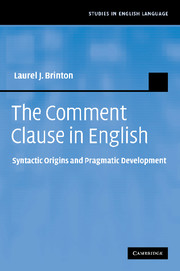Book contents
- Frontmatter
- Contents
- List of figures
- List of tables
- Acknowledgments
- List of abbreviations
- 1 Introduction: comment clauses, parentheticals, and pragmatic markers
- 2 Semantic and syntactic development of pragmatic markers
- 3 Processes of change
- 4 Comment clauses with say
- 5 I mean
- 6 Comment clauses with see
- 7 If you will and as it were
- 8 Comment clauses with look
- 9 What's more and what else
- 10 Epistemic/evidential parentheticals – I gather and I find
- 11 Concluding remarks
- References
- Author index
- Subject index
6 - Comment clauses with see
Published online by Cambridge University Press: 12 July 2009
- Frontmatter
- Contents
- List of figures
- List of tables
- Acknowledgments
- List of abbreviations
- 1 Introduction: comment clauses, parentheticals, and pragmatic markers
- 2 Semantic and syntactic development of pragmatic markers
- 3 Processes of change
- 4 Comment clauses with say
- 5 I mean
- 6 Comment clauses with see
- 7 If you will and as it were
- 8 Comment clauses with look
- 9 What's more and what else
- 10 Epistemic/evidential parentheticals – I gather and I find
- 11 Concluding remarks
- References
- Author index
- Subject index
Summary
Introduction
Despite being widely mentioned as a pragmatic marker in Present-day English, the comment clauses (as/so) you see and see receive scant treatment in the scholarly literature. Only one book (Erman 1987) contains a full-length treatment of you see in Present-day English, and the history of the form receives brief treatment in Fitzmaurice (2004). This chapter begins with a review of the function of you see-type comment clauses in Present-day English (§6.2). It then turns to the rise of these forms in the history of English, focusing first on (as/so) you see (§6.3) and then on see (§6.4). Section 6.5 discusses the relation of the different forms and accounts for their development syntactically and semantically; a comparison of related forms in Swedish is included (§6.5.1). The chapter ends with a discussion of the grammaticalization of the forms (§6.5.2).
You see, as/so you see, and see in Present-day English
You see
Typical instances of you see in Present-day English are illustrated below from a variety of dialects:
(1) a. That was his tragedy you see, to have failed at so many things, when he might have been the best at this one thing (1986 Kidman, “The Whiteness,” Landfall 40.2 [WC]).
b. He simply does not have the money to drink. Your grandma controls the purse strings now, you see (1986 Cordner, The Mavis Singing: The Story of an Australian Family [ACE]).
c. I found all this uniquely reassuring. Everyone knew his place, you see (1991 Lee, “Once upon a Time in the Park,” Interzone [FLOB]).
- Type
- Chapter
- Information
- The Comment Clause in EnglishSyntactic Origins and Pragmatic Development, pp. 133 - 161Publisher: Cambridge University PressPrint publication year: 2008



